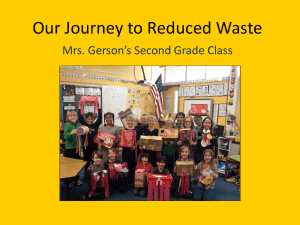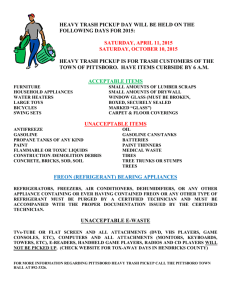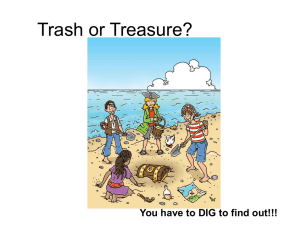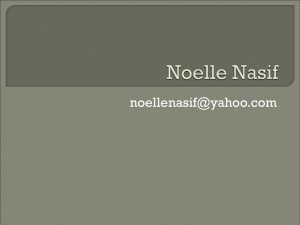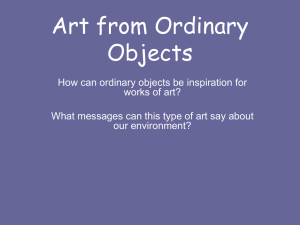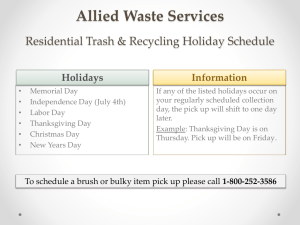Chemistry Landfill Project Goal: To learn about the growing problem
advertisement
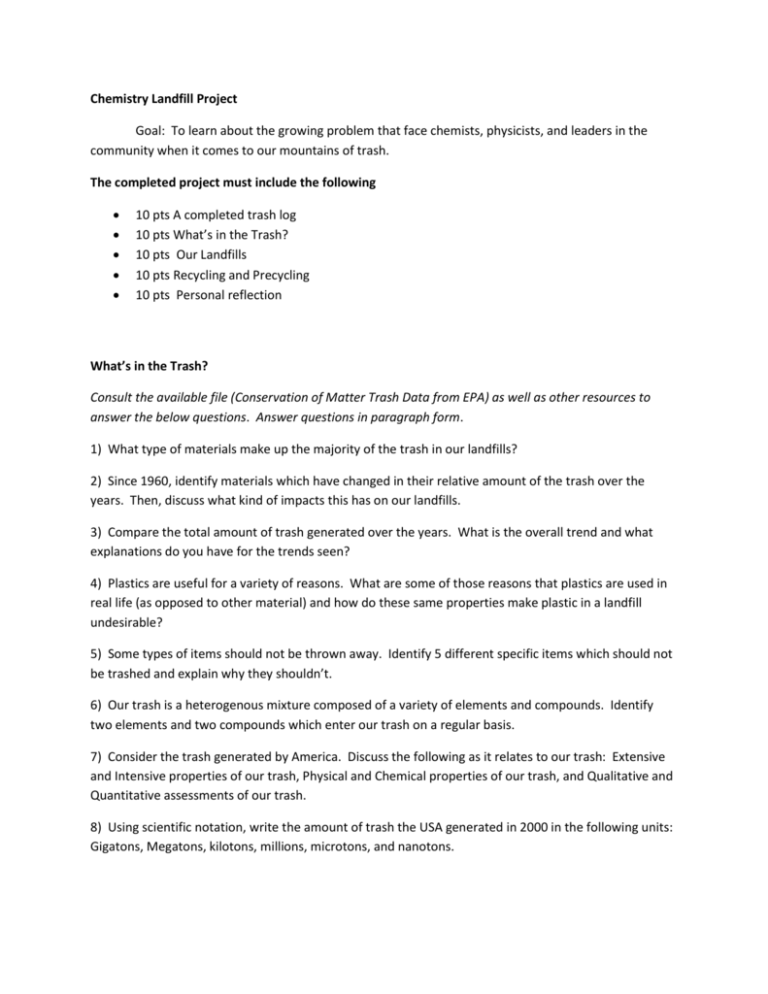
Chemistry Landfill Project Goal: To learn about the growing problem that face chemists, physicists, and leaders in the community when it comes to our mountains of trash. The completed project must include the following 10 pts A completed trash log 10 pts What’s in the Trash? 10 pts Our Landfills 10 pts Recycling and Precycling 10 pts Personal reflection What’s in the Trash? Consult the available file (Conservation of Matter Trash Data from EPA) as well as other resources to answer the below questions. Answer questions in paragraph form. 1) What type of materials make up the majority of the trash in our landfills? 2) Since 1960, identify materials which have changed in their relative amount of the trash over the years. Then, discuss what kind of impacts this has on our landfills. 3) Compare the total amount of trash generated over the years. What is the overall trend and what explanations do you have for the trends seen? 4) Plastics are useful for a variety of reasons. What are some of those reasons that plastics are used in real life (as opposed to other material) and how do these same properties make plastic in a landfill undesirable? 5) Some types of items should not be thrown away. Identify 5 different specific items which should not be trashed and explain why they shouldn’t. 6) Our trash is a heterogenous mixture composed of a variety of elements and compounds. Identify two elements and two compounds which enter our trash on a regular basis. 7) Consider the trash generated by America. Discuss the following as it relates to our trash: Extensive and Intensive properties of our trash, Physical and Chemical properties of our trash, and Qualitative and Quantitative assessments of our trash. 8) Using scientific notation, write the amount of trash the USA generated in 2000 in the following units: Gigatons, Megatons, kilotons, millions, microtons, and nanotons. Our Landfills Consult http://www.ecokids.ca/pub/eco_info/topics/waste/itsnotwaste/theproblem/how_deal.cfm to answer questions about landfills as well as other resources. 1) Briefly describe a modern sanitary landfill and how it is built. 2) What is ‘leachate?’ How does it form, what is inside of it, and what dangers does it pose to our water supply? 3) Not every state has the same amount of landfills. Some states even ship their waste across state lines. Where does the waste that you produce end up (facility and location)? 4) Landfills didn’t use to be a problem in the public eye. Offer reasons why landfills now are getting more attention and people are beginning to be concerned where the new ones are being built. 5) Many landfills are now being viewed as a valuable resource. Identify one way that landfills are being used as a resource and explain how it is being used. 6) Which of the following two statements do you agree more with: “The world is extremely large and the amount of available resources present is more than we will ever consume. We should not be concerned with running out” or “The world’s resources are quickly being thrown into the dump. Unless there is a drastic change, we will end up burying all of our precious metals and materials in a new mining location” 7) Landfills are home to a variety of chemical changes. What are some examples that show evidence of chemical reactions in a landfill? 8) While much of the landfill is solid, some important parts of it are gases. How are the gases in a landfill different than the solids? 9) Some locations use their trash as a source of energy. Hawaii produces roughly 6 – 8% of their electrical energy by incinerating their trash. Explain where this energy comes from (when burning trash) and what are some negative implications of incinerating our trash? Recycling and Precycling Read http://cwmi.css.cornell.edu/TrashGoesToSchool/TrashIntro.html#anchor898432 and answer the below questions 1) What is the difference between recycling and precycling? Which seems to be more effective? 2) Of the suggested options for reduce, reuse, recycle (for children), choose two and comment on how effective you feel they would be in reducing the amount of trash generated. 3) Of the suggested options for precycling, choose two and comment on how effective you feel they would be in reducing the amount of trash generated. 4) Some raw materials are very difficult to produce. Identify one raw material and explain how it is much more environmentally friendly to recycle it then mine it/produce it from scratch. Be specific. 5) Consider the items you purchase from the store. Identify 3 different items which seemed to use excess packaging and 3 different items which were packaged in a more green way. Identify how they were wasteful or minimized their trash footprint. Personal Reflection Reflect on the following two ideas by writing a 2 paragraph response to each Idea 1: Consider your trash log. How much of the trash that you generated could have been avoided? What can you, your family, your school, and your community do to reduce the amount of trash they generate? Idea 2: Respond to the following quotation and the truths about our trash “Landfill blues: It is almost impossible to go through a day without using disposable products and packaging. Every day we bury valuable resources in our landfills that had a useful life of only a few minutes.”

